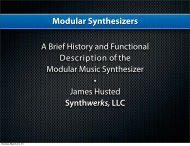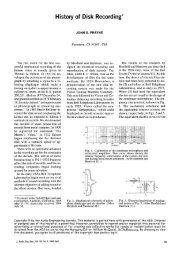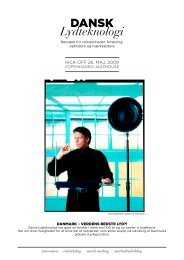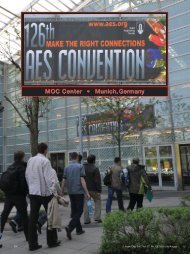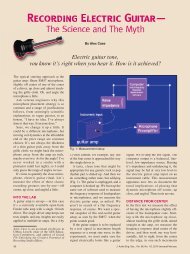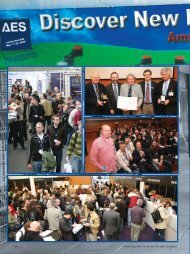Effect of Sound Intensity Level on Judgement of - Audio Engineering ...
Effect of Sound Intensity Level on Judgement of - Audio Engineering ...
Effect of Sound Intensity Level on Judgement of - Audio Engineering ...
You also want an ePaper? Increase the reach of your titles
YUMPU automatically turns print PDFs into web optimized ePapers that Google loves.
frequency resp<strong>on</strong>se remains relativily<br />
unchanged over a range <str<strong>on</strong>g>of</str<strong>on</strong>g> intensities<br />
limited at the upper extreme by the <strong>on</strong>-<br />
set <str<strong>on</strong>g>of</str<strong>on</strong>g> overloading. In this c<strong>on</strong>necti<strong>on</strong>, it<br />
is noteworthy that the 75-db intensity<br />
level is far below the ear's overload<br />
limit. Therefore, we cannot say that the<br />
apparent broadening <str<strong>on</strong>g>of</str<strong>on</strong>g> the flat top <str<strong>on</strong>g>of</str<strong>on</strong>g><br />
the curve is necessarily related to over-<br />
excitati<strong>on</strong> <str<strong>on</strong>g>of</str<strong>on</strong>g> the auditory mechanism.<br />
Another point <str<strong>on</strong>g>of</str<strong>on</strong>g> importance is that<br />
when we raise signal intensity from 50<br />
db to 75 db, we effectively add to the<br />
listener's range at 1 s<strong>on</strong>e, or 1000 milli-<br />
s<strong>on</strong>es, loudness, something over three<br />
octaves downward frpm 400 cps. Put<br />
another way,'by raising the intensity-<br />
level from 50 db to 75 db, we render a<br />
125-cps t<strong>on</strong>e over 90 times louder for<br />
the average listener. By either stater<br />
ment, it is evident that a tremendous im-<br />
provement <str<strong>on</strong>g>of</str<strong>on</strong>g> the ear's effective bass<br />
resp<strong>on</strong>se follows a rise in over-all signal<br />
intensity. To a somewhat lesser extent,<br />
the same is true at the treble end <str<strong>on</strong>g>of</str<strong>on</strong>g> the<br />
spectrum, as these curves suggest. It is<br />
expected that the 50-db c<strong>on</strong>tour, if ex-<br />
tended, would intersect the 100 millis<strong>on</strong>e<br />
(0.1 s<strong>on</strong>e) loudness ordinate just below<br />
20,000 cps, or near the upper frequency<br />
limit <str<strong>on</strong>g>of</str<strong>on</strong>g> normal hearing.<br />
Listener Preferences<br />
Recently a number <str<strong>on</strong>g>of</str<strong>on</strong>g> experimenters<br />
have investigated the preference <str<strong>on</strong>g>of</str<strong>on</strong>g> lis-<br />
teners for various c<strong>on</strong>diti<strong>on</strong>s <str<strong>on</strong>g>of</str<strong>on</strong>g> fre-<br />
quency range and intensity-level in the<br />
reproducti<strong>on</strong> <str<strong>on</strong>g>of</str<strong>on</strong>g> music and speech. Of<br />
the several studies reported, the most ex-<br />
tensively documented appear to be<br />
Eisenberg and Chinn's4 and Ols<strong>on</strong>>.s<br />
In both <str<strong>on</strong>g>of</str<strong>on</strong>g> these experiments, it will be<br />
recalled, listeners were required to com-<br />
pare c<strong>on</strong>secutive passages <str<strong>on</strong>g>of</str<strong>on</strong>g> musical se-<br />
lecti<strong>on</strong>s played through adjustable fre-<br />
quency filters. In Eisenberg and Chinn's<br />
study, electrical filters were employed<br />
restricting the ,range at both ends simul-<br />
taneously. Figzcre 3 shows the three<br />
band-pass characteristics up<strong>on</strong> which<br />
their listeners based judgments <str<strong>on</strong>g>of</str<strong>on</strong>g> "t<strong>on</strong>al<br />
range" preference. The authors note<br />
that these curves apply <strong>on</strong>ly to the elec-<br />
trical porti<strong>on</strong>s <str<strong>on</strong>g>of</str<strong>on</strong>g> their apparatus; in dis-<br />
cussing their results, they imply ,that<br />
these curves also represent c<strong>on</strong>diti<strong>on</strong>s in<br />
the acoustical field surrounding their<br />
listeners. It will also be recalled that<br />
Eisenberg and Chinn studied preference<br />
for program intensity-level, choosing 50,<br />
60, and 70 db as the three values for<br />
comparis<strong>on</strong>. In <strong>on</strong>e series <str<strong>on</strong>g>of</str<strong>on</strong>g> subexperi-<br />
'P. Eisenberg and H. A. Chinn.' T<strong>on</strong>al<br />
range and volume level preferences <str<strong>on</strong>g>of</str<strong>on</strong>g> broad-<br />
cast listeners. J. Ex@. Psychol. 35, 5, 374,<br />
October 1945.<br />
6H. F. Ols<strong>on</strong>. Frequency range pref-<br />
erences for speech and music. J. Acow. Soc.<br />
AM. 19,4, 549, July 1947.<br />
ments, these three intensi6-levels were<br />
combined with the three frequency passbands<br />
already described, and the listeners<br />
asked to state preference for the resultant<br />
c<strong>on</strong>diti<strong>on</strong> <str<strong>on</strong>g>of</str<strong>on</strong>g> both "t<strong>on</strong>al range"<br />
and ''volu~e level."' As we have already<br />
seen, when a sufficient change in signal<br />
intensity occurs listeners will report an<br />
apparent change in frequency range<br />
even though no physical c<strong>on</strong>trol <str<strong>on</strong>g>of</str<strong>on</strong>g> passband<br />
has 'been imposed. Now in the<br />
measurement <str<strong>on</strong>g>of</str<strong>on</strong>g> preferences, 'it is important<br />
that the c<strong>on</strong>diti<strong>on</strong>s serving as<br />
bases for judgment be clearly discrim-<br />
-<br />
100 1000<br />
FREQUENCY-'CYCLES PER SECOND<br />
inable to the average observer. If the Fig. 4. Subiective effect <str<strong>on</strong>g>of</str<strong>on</strong>g> Eisenberg and<br />
differences between them be discernible Ckinn's "medium t<strong>on</strong>al range" filters at "high"<br />
(70-db), "moderate" (60-db), and "low" (50<strong>on</strong>ly<br />
by chance, then the observer is db) volume levels. Broken lines indicate cut<str<strong>on</strong>g>of</str<strong>on</strong>g>f<br />
plainly handicapped in stating his pref- effect <str<strong>on</strong>g>of</str<strong>on</strong>g> filters. Note the apparent ineffectiveness<br />
<str<strong>on</strong>g>of</str<strong>on</strong>g> high-pass filters at 50 and<br />
erence with certainty. ~~~~i~~ this in<br />
60 db.<br />
mind, then, let us look at the effects <str<strong>on</strong>g>of</str<strong>on</strong>g><br />
Eisenberg and Chinn's filters up<strong>on</strong> the<br />
auditory spectrum as perceived by an<br />
average observer under the three in-<br />
tensity-levels used. Returning to Fig. 2,<br />
we can estimate from the 50, 60, and 70<br />
db curves the perceptual results <str<strong>on</strong>g>of</str<strong>on</strong>g> sound<br />
transmissi<strong>on</strong> through a system nominally<br />
flat from 40 to 10,000 cps, corresp<strong>on</strong>ding<br />
totthe "wide t<strong>on</strong>al range" <str<strong>on</strong>g>of</str<strong>on</strong>g> these ex-<br />
periments. Figure 4.shows the subjective<br />
effect <str<strong>on</strong>g>of</str<strong>on</strong>g> the "medium-t<strong>on</strong>al-range," that<br />
in<br />
W<br />
z<br />
in 0<br />
10 -<br />
I<br />
% 1-<br />
W z<br />
0 3<br />
3<br />
70 db<br />
100 XMO moo0<br />
FREQUENCY - CYCLES PER SECOND<br />
is, 60 to 6,000 cps, filtering: it will be<br />
noted that a the 'igh Fig. 5. f ubjectivc effect <str<strong>on</strong>g>of</str<strong>on</strong>g> Iisenberg and<br />
level" do the restricti<strong>on</strong>s at both high Chinn's "narrow t<strong>on</strong>al range" filters at ''hirrh"<br />
and low ends become noticeable. At (70-db), "moderate" (60-2b) and "low" (50db)<br />
volume levels. Broken lines indicate cut<str<strong>on</strong>g>of</str<strong>on</strong>g>f<br />
lower levels, the be effect <str<strong>on</strong>g>of</str<strong>on</strong>g> filters. Note relative ineffectiveness<br />
expected to report,mainly - a change in <str<strong>on</strong>g>of</str<strong>on</strong>g> high-pass filter at 50 db, and sliht effect<br />
/<br />
hi&s as a result <str<strong>on</strong>g>of</str<strong>on</strong>g> filteri&'but a iaria- <strong>on</strong> subjective bandwidth at' high eid caused<br />
by change in intensity-levels.<br />
ti<strong>on</strong> <str<strong>on</strong>g>of</str<strong>on</strong>g> both lows and highs would be<br />
reported as a result <str<strong>on</strong>g>of</str<strong>on</strong>g> the-changes in<br />
level. Figz~re.5, showing the effects <str<strong>on</strong>g>of</str<strong>on</strong>g><br />
"narrow-range," that is, 150 to 4,900<br />
cps, filtering, -suggests an opposite c<strong>on</strong>clusi<strong>on</strong><br />
: here the greatest perceived differences<br />
occur at the low-frequency end<br />
as level is varied. Restricti<strong>on</strong> at the high<br />
end is so severe that raising level from<br />
50 to 70 db expands subjective frequency<br />
range hardly more than half an<br />
100<br />
octave upward at 1 s<strong>on</strong>e loudness. Fig-<br />
FREQUENCY -CYCLES PER SECOND<br />
ures 2,4 and 5 indicate that a growth in<br />
the perceived range <str<strong>on</strong>g>of</str<strong>on</strong>g> frequencies prob- Fig. 6. Subjective effect <str<strong>on</strong>g>of</str<strong>on</strong>g> Eisenberg and<br />
Chinn's "wide," "medium" and "narrow t<strong>on</strong>al<br />
ably occurred independently <str<strong>on</strong>g>of</str<strong>on</strong>g> the band- range" filters at 704, intensity-level ("high<br />
pass imposed by means <str<strong>on</strong>g>of</str<strong>on</strong>g> fil- volume level"). Broken lines indicate cut<str<strong>on</strong>g>of</str<strong>on</strong>g>f<br />
ters.<br />
effect <str<strong>on</strong>g>of</str<strong>on</strong>g> filters.<br />
In Figs. 6, 7 a%d 8 we can see the "medium", that is, "A" with "B", diseffects<br />
<str<strong>on</strong>g>of</str<strong>on</strong>g> filtering at any <strong>on</strong>e <str<strong>on</strong>g>of</str<strong>on</strong>g> the criminativn is likely to be uncertain,<br />
three intensity-levels. Figure 6 suggests yieldin2 statements <str<strong>on</strong>g>of</str<strong>on</strong>g> preference not acthat<br />
at "high-volume level" the average ceptably reliable. Figzcre 7 shows an aglistener<br />
would experience little difficulty gravati<strong>on</strong> <str<strong>on</strong>g>of</str<strong>on</strong>g> this difficulty, brought about<br />
discerning the shift from "wide" to "nar- by reducing intensity-level to 60 db.<br />
row" ranges, that is, from band A to Here the three batids become more easily<br />
band C. Likewise, the shift from "me- c<strong>on</strong>fused, although discriminati<strong>on</strong> <str<strong>on</strong>g>of</str<strong>on</strong>g><br />
dium" to "narrow", band B to band C; :wide" (A) from "narrow" (C) might<br />
probably would be easily detected. HOW- still be accomplished with better than<br />
ever, in comparis<strong>on</strong>s <str<strong>on</strong>g>of</str<strong>on</strong>g> "wide" with chance success. Figure 8 presents a pic-<br />
AUDIO ENGINEERING * JUNE, 1951



